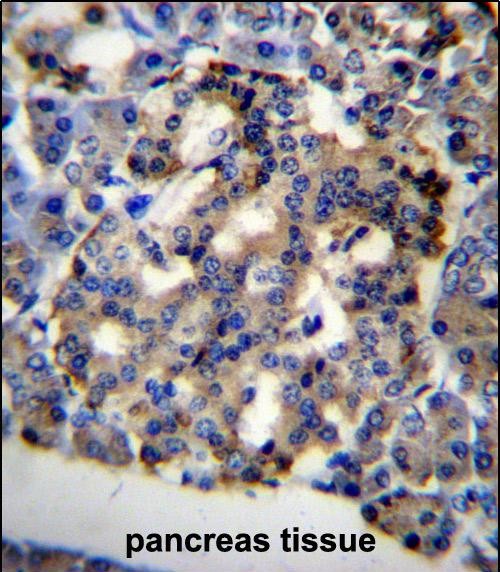TWNK Antibody (C-term)
Affinity Purified Rabbit Polyclonal Antibody (Pab)
- SPECIFICATION
- CITATIONS
- PROTOCOLS
- BACKGROUND

Application
| WB, IHC-P, E |
|---|---|
| Primary Accession | Q96RR1 |
| Other Accession | NP_001157284.1, NP_068602.2 |
| Reactivity | Human |
| Host | Rabbit |
| Clonality | Polyclonal |
| Isotype | Rabbit IgG |
| Calculated MW | 77154 Da |
| Antigen Region | 656-684 aa |
| Gene ID | 56652 |
|---|---|
| Other Names | Twinkle protein, mitochondrial, Progressive external ophthalmoplegia 1 protein, T7 gp4-like protein with intramitochondrial nucleoid localization, T7-like mitochondrial DNA helicase, PEO1, C10orf2 |
| Target/Specificity | This C10orf2 antibody is generated from rabbits immunized with a KLH conjugated synthetic peptide between 656-684 amino acids from the C-terminal region of human C10orf2. |
| Dilution | WB~~1:1000 IHC-P~~1:10~50 E~~Use at an assay dependent concentration. |
| Format | Purified polyclonal antibody supplied in PBS with 0.09% (W/V) sodium azide. This antibody is purified through a protein A column, followed by peptide affinity purification. |
| Storage | Maintain refrigerated at 2-8°C for up to 2 weeks. For long term storage store at -20°C in small aliquots to prevent freeze-thaw cycles. |
| Precautions | TWNK Antibody (C-term) is for research use only and not for use in diagnostic or therapeutic procedures. |
| Name | TWNK (HGNC:1160) |
|---|---|
| Synonyms | C10orf2, PEO1 |
| Function | [Isoform 1]: Mitochondrial helicase involved in mtDNA replication and repair (PubMed:12975372, PubMed:15167897, PubMed:17324440, PubMed:18039713, PubMed:18971204, PubMed:25824949, PubMed:26887820, PubMed:27226550). Might have a role in mtDNA repair (PubMed:27226550). Has DNA strand separation activity needed to form a processive replication fork for leading strand synthesis which is catalyzed by the formation of a replisome complex with POLG and mtSDB (PubMed:12975372, PubMed:15167897, PubMed:18039713, PubMed:22383523, PubMed:26887820, PubMed:27226550). Preferentially unwinds DNA substrates with pre-existing 5'-and 3'- single-stranded tails but is also active on a 5'- flap substrate (PubMed:12975372, PubMed:15167897, PubMed:18039713, PubMed:22383523, PubMed:26887820, PubMed:27226550). Can dissociate the invading strand of immobile or mobile D-loop DNA structures irrespective of the single strand polarity of the third strand (PubMed:27226550). In addition to its DNA strand separation activity, also has DNA strand annealing, DNA strand-exchange and DNA branch migration activities (PubMed:22383523, PubMed:26887820, PubMed:27226550). |
| Cellular Location | Mitochondrion matrix, mitochondrion nucleoid Mitochondrion inner membrane; Peripheral membrane protein. Note=Colocalizes with mtDNA in mitochondrial nucleoids, a nucleoproteins complex consisting of a number of copies of proteins associated with mtDNA, probably involved in mtDNA maintenance and expression (PubMed:11431692) Associates with phospholipid membranes via electrostatic binding (By similarity). Preferentially associates with membranes enriched with cardiolipin, a lipid abundant in the mitochondrial inner membrane (PubMed:34950192). ATPase and helicase activity is enhanced by binding to lipid membranes (PubMed:34950192). {ECO:0000250|UniProtKB:Q9VL76, ECO:0000269|PubMed:11431692, ECO:0000269|PubMed:34950192} |
| Tissue Location | High relative levels in skeletal muscle, testis and pancreas. Lower levels of expression in the heart, brain, placenta, lung, liver, kidney, spleen, thymus, prostate, ovary, small intestine, colon and leukocytes. Expression is coregulated with MRPL43 |

Thousands of laboratories across the world have published research that depended on the performance of antibodies from Abcepta to advance their research. Check out links to articles that cite our products in major peer-reviewed journals, organized by research category.
info@abcepta.com, and receive a free "I Love Antibodies" mug.
Provided below are standard protocols that you may find useful for product applications.
Background
This gene encodes a hexameric DNA helicase which unwinds short stretches of double-stranded DNA in the 5' to 3' direction and, along with mitochondrial single-stranded DNA binding protein and mtDNA polymerase gamma, is thought to play a key role in mtDNA replication. The protein localizes to the mitochondrial matrix and mitochondrial nucleoids. Mutations in this gene cause infantile onset spinocerebellar ataxia (IOSCA) and progressive external ophthalmoplegia (PEO) and are also associated with several mitochondrial depletion syndromes. Alternative splicing results in multiple transcript variants encoding distinct isoforms.
References
Longley, M.J., et al. J. Biol. Chem. 285(39):29690-29702(2010)
Wang, W., et al. Nucleic Acids Res. (2010) In press :
Fratter, C., et al. Neurology 74(20):1619-1626(2010)
Kruger, J., et al. Mol Neurodegener 5, 8 (2010) :
Bohlega, S., et al. Neuromuscul. Disord. 19(12):845-848(2009)
If you have used an Abcepta product and would like to share how it has performed, please click on the "Submit Review" button and provide the requested information. Our staff will examine and post your review and contact you if needed.
If you have any additional inquiries please email technical services at tech@abcepta.com.













 Foundational characteristics of cancer include proliferation, angiogenesis, migration, evasion of apoptosis, and cellular immortality. Find key markers for these cellular processes and antibodies to detect them.
Foundational characteristics of cancer include proliferation, angiogenesis, migration, evasion of apoptosis, and cellular immortality. Find key markers for these cellular processes and antibodies to detect them. The SUMOplot™ Analysis Program predicts and scores sumoylation sites in your protein. SUMOylation is a post-translational modification involved in various cellular processes, such as nuclear-cytosolic transport, transcriptional regulation, apoptosis, protein stability, response to stress, and progression through the cell cycle.
The SUMOplot™ Analysis Program predicts and scores sumoylation sites in your protein. SUMOylation is a post-translational modification involved in various cellular processes, such as nuclear-cytosolic transport, transcriptional regulation, apoptosis, protein stability, response to stress, and progression through the cell cycle. The Autophagy Receptor Motif Plotter predicts and scores autophagy receptor binding sites in your protein. Identifying proteins connected to this pathway is critical to understanding the role of autophagy in physiological as well as pathological processes such as development, differentiation, neurodegenerative diseases, stress, infection, and cancer.
The Autophagy Receptor Motif Plotter predicts and scores autophagy receptor binding sites in your protein. Identifying proteins connected to this pathway is critical to understanding the role of autophagy in physiological as well as pathological processes such as development, differentiation, neurodegenerative diseases, stress, infection, and cancer.



